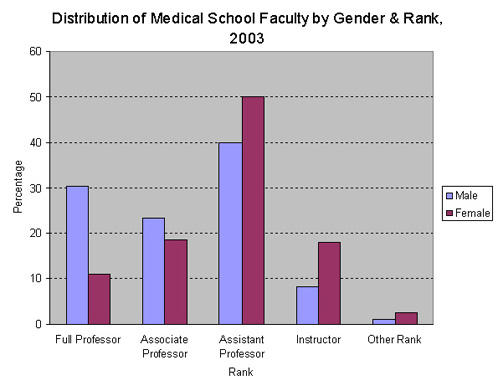By the Numbers
Women in Academic Medicine and Dentistry
Though there have been dramatic increases in the number of women entering medical and dental schools since the 1960s, the rise in the number of woman faculty members has not been equally dramatic.
Association of American Medical Colleges (AAMC) data reveals that women are more likely to be instructors and assistant professors than men. Men are more likely to be full and associate professors than women.
According to data compiled by the Association of American Medical Colleges, in 2003 women comprised 29.3% of all medical school faculty members. Women were disproportionately represented at the lower ranks of academic medicine: women made up 13.1% of all full professors and 24.8% of all associate professors. Almost 36% of all assistant professors were women, and 47.3% of all instructors were women. Women comprise 12% of all full professors who are also tenured.
AAMC data reveals that these distribution statistics have remained stable for almost 20 years.
| Rank | 1985 | 1989 | 2003 |
|---|---|---|---|
| Full Professor | 10% | 9% | 11% |
| Associate Professor | 20% | 20% | 18.6% |
| Assistant Professor | 47% | 49% | 50% |
| Instructor | 19% | 18% | 17.9% |
| Other Ranks | 4% | 4% | 2.5% |
Studies published in the Journal of the American Medical Association, Academic Medicine, New England Journal of Medicine, and Annals of Internal Medicine show women are less likely to be promoted than men. A study of all women and a sample of men physician faculty appointed in 1979-80 found that eleven years later, 59% of the women compared to 83% of the men had reached associate or full professor rank. Only 5% of the women compared to 23% of the men had achieved the rank of full professor. In academic administrative roles, 115 women chaired a department in 1995. In 2001 women chaired approximately 214 departments – an average of just 1.7 per medical school.
As of 2002, there are over 400 women assistant, associate, and senior associate deans in United States medical schools – an average of 3 per school. Of the 125 medical schools in the United States, nine have women deans (as of October 2004). Of those nine, two are in the state of Missouri: Betty M. Drees, M.D. at the University of Missouri-Kansas City School of Medicine and Patricia L. Monteleone, M.D. at St. Louis University School of Medicine.
The progress of women in academic dentistry lags slightly behind that made by women in academic medicine. While the advances have been substantial, there still are a significant number of U.S. dental schools without women in faculty leadership roles.
American Dental Education Association figures indicate that by 1986 women comprised approximately 27% of dental school students in the United States. However, in the 60 U.S. Dental Schools at that time, women made up only 5% of the deans, associate deans, and assistant deans. Only 5.8% of department chairs, program directors, or clinic directors were women.
In 1991-92, only 16 (28.5%) of the then 56 U.S. dental schools had women associate and assistant deans. By 2001-02, 41 (74.5%) of the 55 U.S. dental schools had women associate and assistant deans. In 1994-95, 24 (44%) of U.S. dental schools had women in department chair positions; in 2001-02 the number had risen to 33 (60%). Seven (12.7%) of the 55 U.S. dental schools had appointed women as deans or interim or acting deans by 2002.
In the 2000-01 school year, women comprised 24% of all dental school faculty members – 25% of the full-time faculty positions and 23% of the part-time faculty positions. Women comprised 38.7% of the dental school student enrollment that year.
Though the statistics in both academic medicine and dentistry show progress, there is still much room for improvement in the status and role of women. The leadership potential of women in academic medicine and dentistry continues to be underused, unfulfilled and unrealized.
Related Links:
Return to By the Numbers
Back to Top


